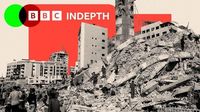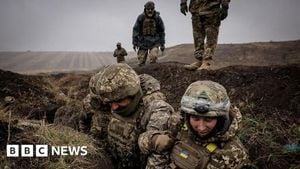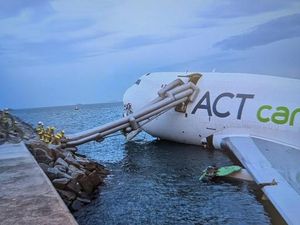On the battered landscape of Gaza, hope and heartbreak intertwine as the territory emerges from two years of devastating conflict between Israel and Hamas. The ceasefire, reached in early October 2025 after intense international mediation, was supposed to signal a new era of calm. Yet, for many Palestinians, the reality has been far more complicated, with ceasefire violations, humanitarian crises, and lingering uncertainty about the future.
French Foreign Minister Jean-Noel Barrot, speaking before a European Union foreign ministers' meeting in Luxembourg on October 20, 2025, minced no words in his assessment. According to TRT World, Barrot condemned recent Israeli airstrikes on Gaza as "violations of the ceasefire agreement reached in Sharm el-Sheikh," calling on all parties to "strictly respect the commitments they made." Barrot's statement underscored the growing frustration among European leaders over the fragility of the truce and the urgent need for stability in the region.
Barrot's remarks came as reports from Gaza painted a grim picture. According to Democracy Now!, Gaza officials have accused Israeli forces of violating the ceasefire agreement approximately 80 times since it took effect. The most harrowing incident occurred on October 17, when Israeli military forces opened fire on a civilian bus in Gaza City, killing 11 members of the Abu Shaaban family, including seven children aged five to thirteen. Dozens more Palestinians died in subsequent airstrikes after Israel claimed militants had attacked its soldiers, though conflicting reports suggested the soldiers' deaths were caused by their bulldozer running over unexploded ordnance.
For many in Gaza, the war has not truly ended. Al Jazeera reporter Ibrahim al-Khalili, who has covered the conflict since its outbreak in October 2023, described the ongoing hardships: "Israel is breaching the ceasefire. The war has not really ended for hundreds of thousands of Palestinians who are still struggling to survive the next day with the lack of basic necessities." Al-Khalili's own family was not spared; he lost several relatives in an Israeli airstrike, and his brother Mohammed was held captive by Israeli forces for 19 months, only to be released last week as part of a prisoner exchange.
The ceasefire agreement, brokered with the support of the United States and other international partners, included the return of 20 Hamas-held hostages to Israel and the release of nearly 2,000 Palestinian detainees. Yet the celebrations that marked these releases have been tempered by the ongoing violence and dire humanitarian conditions. According to BBC, Ayish Younis, an 89-year-old Palestinian who has lived through multiple wars and displacements, now finds himself once again in a tent near Khan Younis, after his home in Rafah was destroyed in May 2024. "We returned to what we started with, we returned back to tents, and we still don't know how long we will be here," he said, his voice heavy with resignation.
Younis's story is a microcosm of Gaza's recent history. He first fled his village of Barbara in 1948 during the Arab-Israeli war, joining an estimated 700,000 Palestinians who became refugees. After decades of rebuilding, his family—now boasting 18 children and 79 grandchildren, many of whom are university graduates—has been scattered by conflict once more. "After we left Barbara and lived in a tent, we eventually succeeded in building a house. But now, the situation is more than a catastrophe. I don't know what the future holds, and whether we will ever be able to rebuild our house again," he reflected.
The destruction wrought by the war has left Gaza's infrastructure in ruins. Schools, hospitals, and basic services have been decimated, and access to running water and electricity remains scarce. Younis's son Haritha, also living in a tent, lamented, "An entire generation has been destroyed by this war. My daughter has gone through two years of war without schooling, and for two years before that schools were closed because of Covid. We don't know how things will unfold or how we will have a source of income. There are so many questions we have no answers for."
International efforts to address the crisis have gained momentum. Barrot outlined a comprehensive approach to stabilizing Gaza, calling for Hamas to "cease violence against civilians" and return the remains of remaining hostages. He advocated for expanding the EU Border Assistance Mission in Rafah to facilitate the movement of people and goods, and for extending the EU's policing mission (EUPOL COPPS) from the West Bank to train Palestinian security forces for Gaza deployment under a UN mandate. France also committed to co-organizing an international conference with Egypt, the United States, and others to coordinate humanitarian assistance and reconstruction.
Despite these diplomatic initiatives, the challenges remain daunting. Aid distribution has been hampered by ongoing restrictions. As Democracy Now! reported, Israel continues to limit the flow of humanitarian supplies into Gaza, suspending the entrance of aid even after the ceasefire was declared. Al-Khalili noted, "Before the war, Gaza needed at least 500 trucks' worth of food and medicine to help support the population in the Gaza Strip." Now, those needs are even greater, and the pipeline of relief remains unreliable.
The psychological toll is immense. Many Palestinians released from Israeli prisons have described torture and harsh conditions. Al-Khalili's brother Mohammed recounted, "We were beaten and humiliated in wrong ways. We suffered a lot." Others, like Shadi Abu Sido, emerged from detention to discover their families alive after being told they had been killed—a psychological tactic reportedly used by Israeli authorities to torment prisoners.
As the international community debates the best path forward, questions about Gaza's future loom large. Younis is deeply pessimistic: "I don't believe Gaza has any future." He doubts that the territory can rebuild without significant international support and worries that the younger generation faces limited prospects. Yet, amid the despair, there are flickers of hope. Younis's eldest son Ahmed, a spinal cord injury specialist living in London, dreams of returning to Rafah after retirement. "The hope is always in the new generation to rebuild," he said, his optimism tempered by the hard lessons of the past.
Meanwhile, European leaders are linking the crisis in Gaza to broader regional and global security concerns. Barrot, while reiterating French support for the US-led ceasefire plan, also announced continued EU backing for Ukraine as its own conflict reached the 1,000-day mark. He unveiled a new European Commission loan to help Ukraine defend itself for at least three years, to be repaid through future Russian reparations, and proposed fresh sanctions targeting Russia's energy sector.
For Gaza, the path to recovery is fraught with obstacles—political, logistical, and human. The ceasefire may have paused the worst of the violence, but the wounds run deep, and the future remains uncertain. Yet, as families like the Younises cling to memories of lost villages and the hope of rebuilding, the story of Gaza is far from over.




